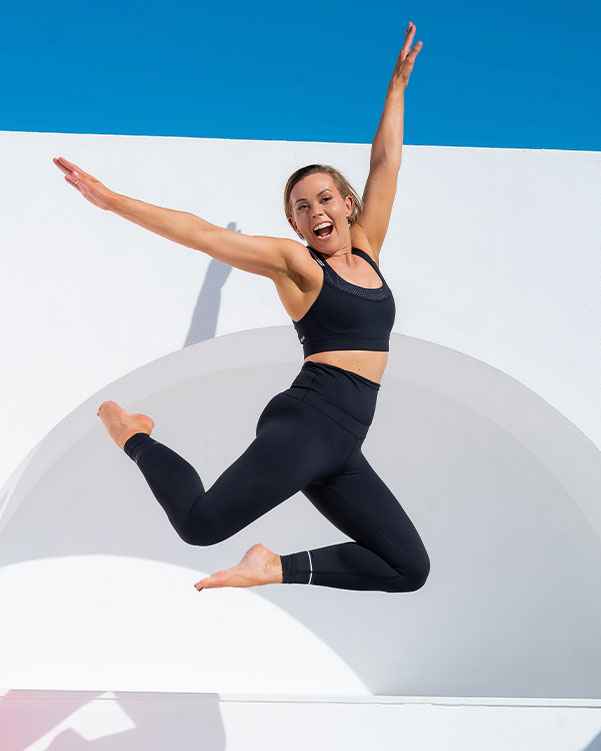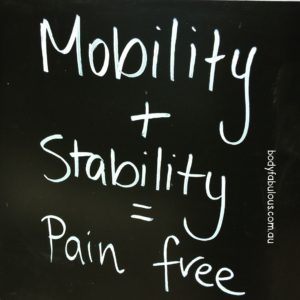Are you suffering pregnancy or post birth aches and pains ?
I completely understand I suffered from severe sciatica after my 3rd labour. It was hard to walk and bending over my little newborn girl’s cot was absolute torture.
I thought gentle stretching and some yoga would fix it, but I continued to have shooting pain down my back and right leg for several months.
The only thing that I found helped was regular visits to my Physio plus improving my mobility using a medical grade fit ball and gentle resistance training.
My personal experience with this condition has now made me focus on 3 things with all my pregnant and post natal clients to ensure pregnancy and post pregnancy aches and pains are reduced these include :
Stability
Unstable hips are very common during pregnancy due to the hormone relaxin in your system – find out about how 1 in 5 women have on pelvic instability.
Your hips become super mobile or lax, especially around your sacroiliac joints and lower back. Together with reduced strength in your glutes and core (as you are growing a bub) it is difficult for your hips to stabilize. Relaxin can also remain in your system up to 12 months post birth, especially if you are breastfeeding – yep this is why I suffered post birth aches and pains !
It is important to realise that you can’t stretch your way out of pelvic pain, it could actually make the inflammation around your hips and pelvis worse. Watch my video here to learn more.
To improve stability and to protect the hips and pelvis I often use a medical grade fitball for many exercises with my pregnant and post natal PT clients. The fitball provides support for your hips and lower back and gently activates your core. You will also find medical grade fit balls many birth suites in hospitals.
Note – it is important, if you use a fit ball – that is is firm and that your hips are higher than your knees when seated on it. If you are want to purchase a quality / medical grade fitball that is the correct size for your height contact me.
Mobility
You can reduce pain from stretching, however sometimes pain is not caused not from tightness but from weakness. This means mobility and functional strength training must be a focus.
Think about how you need to move as a busy mother…bending over prams, leaning over change tables, twisting in out of cars, carrying bags, lifting toddlers etc. It is so important to prepare and strengthen your body for these “mummy moves” during pregnancy.
This doesn’t mean exercising during pregnancy or after with the goal of stronger, faster harder. It means focusing on the functional movement of every concentric and eccentric movement with appropriate resistance.
Mobility exercises are essential to keep joints and muscles moving through their full range of motion. Grab my complimentary core training guide to help you get mobile safely both during and after pregnancy.
Resistance Training and Hip Stability
Resistance training on targeted areas helped my body focus on hip stability which in turn improved by aches and pains. Hip stability is your ability to maintain your center of gravity and produce strength and coordination in your hips and trunk — or core muscles. Hip stability works with hip mobility — freedom of movement — to produce a variety of movement patterns. Also, having strong and stable hips reduces the risk of injury in your pelvic joints, spine and knees.
3 Hip stabilization exercises that are essential to improve and pregnancy aches and pains.
1. Bridges
Bridging is where you lift your hips up from a supine position. It activates your buttocks and hip stabilizers in your hip joints where your femurs attach to your pelvis. By strengthening your buttocks and pelvic floor muscles, you can alleviate some back pain and tight hip flexors. This is good for post natal women who have weak hips and mild back stiffness, since the supine position on the floor lessens pressure upon the spine.
How to do a Bridge : Lay on the floor with your arms at your sides and palms facing up. Bend your hips and knees, and bring your heels close to your buttocks. Keep your legs about hip-width apart and your toes pointing forward. Exhale and lift your hips off the ground without hyperextending your lower back or lifting your toes. Hold for two deep breaths and lower your hips to the ground.
Anterior pelvic tilt is common among all pregnant and post natal women due to postural alignment changes to make way for your body. Focusing on an exercise like bridges builds proper glute activation, avoiding lower back pain caused by an anterior pelvic tilt position.
2. Deadlifts
Start with a weighted bar or dumbell in either hand near your your mid-thighs, your arms are long. Tip from the hip moving your hips back while bending your legs slightly as the weight shaves the tops of your thighs, and moves to target your knees. Then slowly return to the top.
Your lower back must stay neutral to avoid injury. Rounding it during heavy Deadlifts is dangerous for your spine, so keep your chest high. It puts uneven pressure on your spinal discs which can injure them. Always Deadlift with a neutral lower back – maintain the natural inward curve of your lower spine – breathe throughout the movement.
Deadlifts are a fantastic way to strengthen your posterior chain – or everything that runs down the back of your body. Think about the weight of your baby in the anterior position and all the forward / anterior movements you do as a mum – we want to balance this with a strong posterior chain.
3. Squats
Squats are my favourite exercise. When done correctly squats, increases your core and hip stability and mobility. The downward movement takes your hips and legs in a full, lower squat and retrains your nervous system to activate your core and hips to generate stability in movement. Squats are also great a warm-up …oh and don’t forget you will be squatting down a million times a day when you have a baby and toddler. So learn how to do this correctly so your posture and back is not compromised.
Stand with your feet shoulder-distance apart and your toes pointing forward in front of a step or a similar platform that you can put your hands on. Raise your arms above your head take a deep breath in, then exhale and bend arms forward to place your palms on a platform like a kitchen bench (connecting movement with your breathe is essential). Slowly lower your hips into a squat while keeping your spine tall and chest high. If pregnant make sure you don’t drop your hips lower than your knees to protect your lower back.
As you lower inhale your breath and as you rise exhale – this diaphragmatic breathing will also help to naturally activate your pelvic floor. Read here why.
Hold the squat position for a few deep breaths. This is also a great way to prepare for labour – as you might be in this position during birth !
If you feel your chest is dropping too far forward as you bend your knees – try supporting yourself with a fitball positioned in your lower back – as pictured.
Follow my video for safe and effective squats :
Above all, remember injury prevention is much easier than injury cause. Stronger faster, harder not the goal during pregnancy or post natally. You are now in maintenance mode !
Listen to your body and do only what feels right. If you have any continuing aches and pains – please see a medical practitioner.
Also try to consult a Trainer who can provide you with an effective personalised program. As every body is very different especially during and after pregnancy. Or get started with my complimentary pregnancy and postpartum guide here.
Any questions connect with me in my Facebook Community #BFABSQUAD
xx

About Dahlas
Dahlas Fletcher is one of Australia’s most respected and successful certified and experienced Pregnancy and Female Fitness Trainers. Her goal is to help you be the happiest, most fabulous version of yourself, inside and out.








